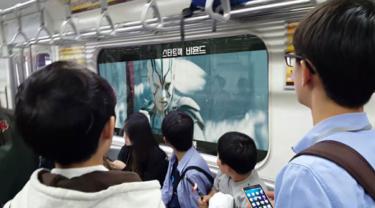There are few things Ken Bicknell likes to see more than a long expanse of blank wall in a metro subway tunnel. To the CEO and President of Vancouver-based adtrackmedia, the wall represents valuable real estate just waiting to be filled by the company’s state-of-the art digital advertising technology.
And with concession agreements already in place with some of the world’s biggest metro operators, Bicknell believes adtrackmedia is poised to consolidate its position as a world leader in one of the most technologically innovative advances ever in advertising.
adtrackmedia’s niche, the tunnel walls of a subway system, represent a large opportunity and one of the last undeveloped transit assets for out-of-home advertising displays. The company’s technology turns a dark void outside the train windows that riders generally ignore into an entertaining and informative medium for fast-paced, movie-like ads that drive new revenue streams for metro operators using space that was previously going to waste.
Since being awarded its first concession in 2013 by the Via Quatro metro system in Sao Paulo, Brazil, adtrackmedia has won additional concessions to install and operate its technology in Seoul, South Korea, Madrid, Spain, Mexico City and Los Angeles in the U.S.
Bicknell says while the company’s initial business plan was to target the top 20 global metros, the focus has since been widened to all cities with major metro systems.
“There are 150 cities in the world with metros, but many of the very large cities have multiple metro operators. In Tokyo for example, there are seven or eight companies that operate subways now and each of them is the size of a reasonable metro elsewhere in the world. So, there are many and various opportunities for us,” he says.
The basis for adtrackmedia’s technology was developed by a Japanese inventor and commercialized by two South Korean companies working on parallel paths. It was then licenced by a Canadian company, which adtrackmedia acquired in 2011, and subsequently also acquired all the technology and hired both commercialization teams.
Then, working together with the original inventor, the company developed an enhanced media-focused platform that attracted the interest of major metro operators looking for new ways to generate revenue and brand looking for impactful ways to reach consumers.
“It’s Canadian-owned technology now with significant enhancements and improvements based on the needs of a media operating entity versus pure technology,” says Bicknell.
Initially, adtrackmedia entered into concession agreements with metros and installed and operated the technology and, where needed, sold the advertising as well. The company has since expanded its market access strategy to include selling the technology and licensing its software and services as a bundled product either directly to metro authorities or to advertising companies.
“We need to convince a metro operator to issue an RFP for a product like ours,” he adds. “And even if they are interested, it tends to be a very long sales cycle. But we can shorten it if we partner more closely with the operators and with advertising companies in those markets.”
A new export sales office has been opened in Suwon City just outside Seoul in South Korea to facilitate this process. The company also has a manufacturing facility and an innovation centre in Suwon City.
While adtrackmedia’s systems are completely designed and engineered in-house, Bicknell says having a manufacturing centre in South Korea gives the company ready access to the electronics, assemblies and componentry it needs.
With advertisers like McDonald’s, Coca-Cola, Acer, Intel, Google and Unilever already seeing the added value of reaching riders as their trains whizz through previously dark drab tunnels, adtrackmedia seems set to play an increasingly significant role on the global advertising stage.
Export insights with CEO and President Ken Bicknel
What was your biggest challenge in breaking into the market?
To convince metro operators that we could install our hardware in their tunnels safely and without disrupting rail traffic. The diligence required for our first installations was off the charts. We also had to prove that we had a viable and sustainable technology platform that would generate incremental revenues for the metros and provide an improved and exciting experience for riders.
What are your target markets for expansion?
We are currently focused on Asia, Europe and North America where we have a significant amount of ongoing business development. Our sales cycle with metros is typically two years and we started our aggressive growth in 2015, so right now we are in that window where many opportunities are maturing for us. We are optimistic that we’re going to see a significant number of announcements and concession agreements in the next six to 12 months.





